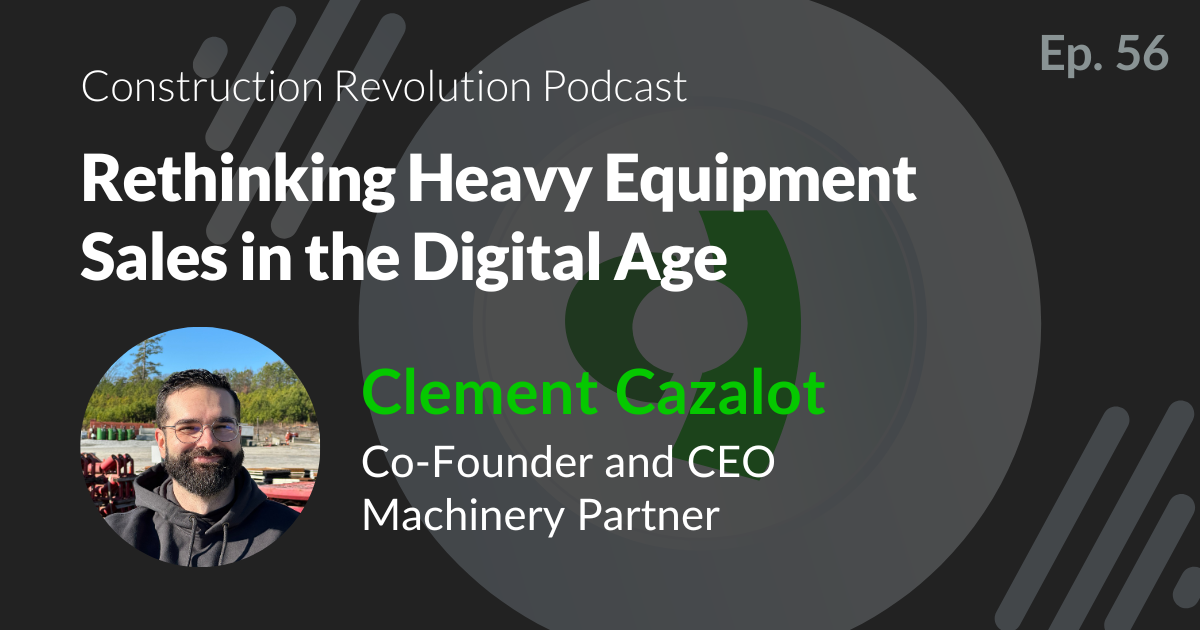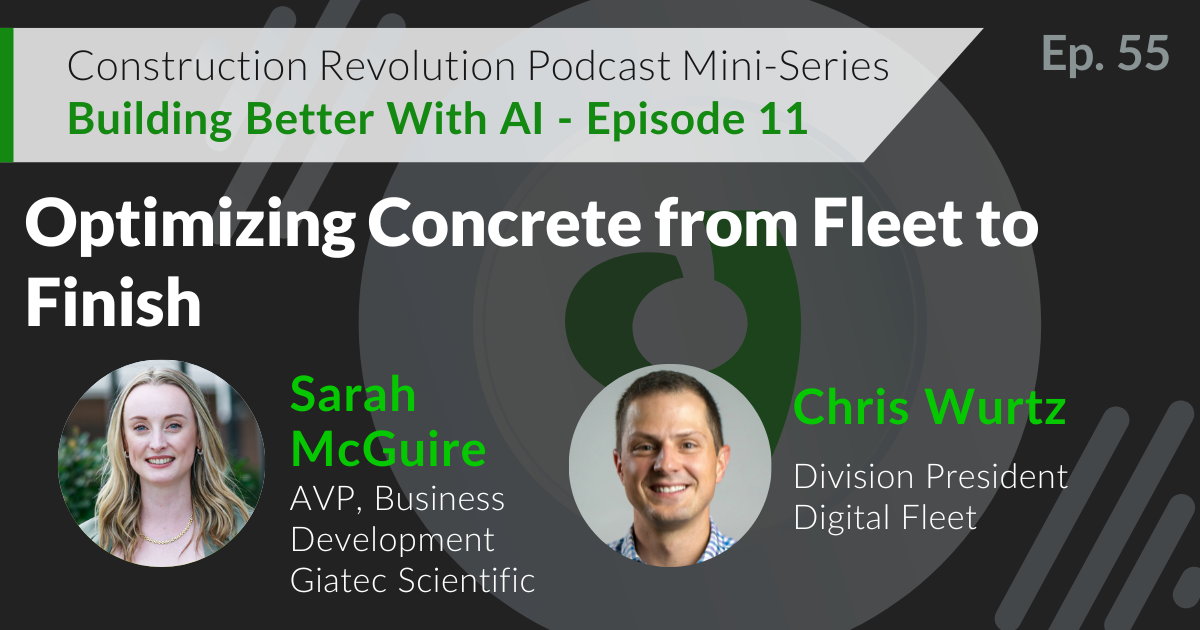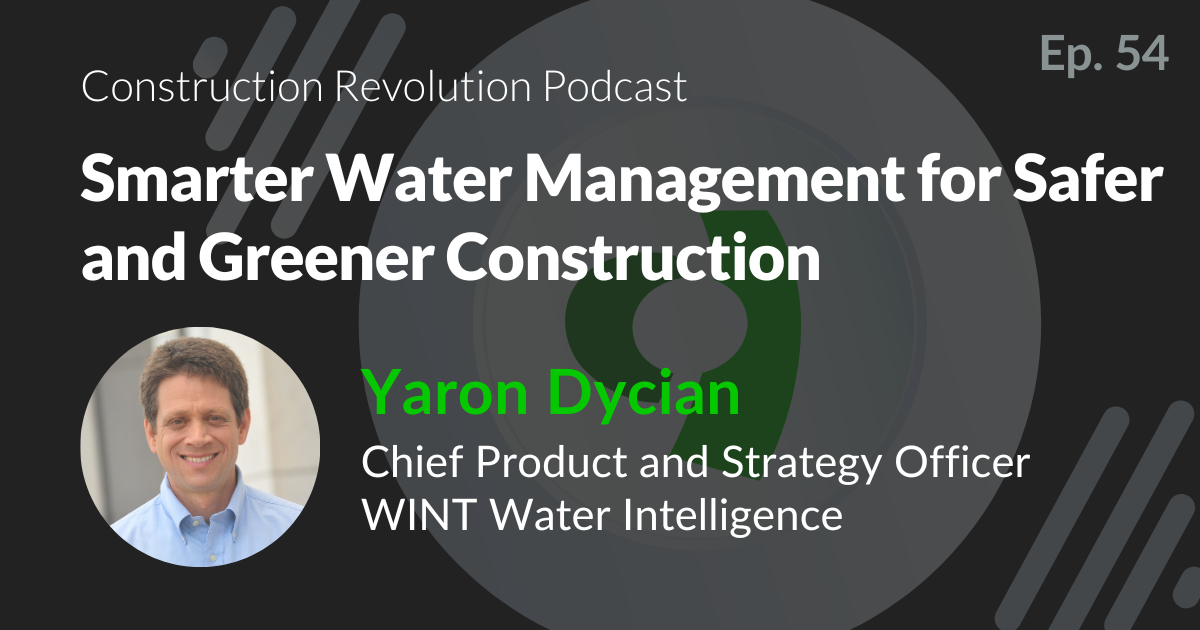
Episode 5 |
April 13, 2021
Concrete Mix Optimization and Artificial Intelligence
In This Episode
In this episode hear from Andrew Fahim, Giatec’s Senior Manager of Research and Development about his personal story of how he joined Giatec and his passion for finding smart solutions. Learn about the latest technologies Giatec is developing and the company’s sustainability initiative through their artificial intelligence tool, SmartMix.

Host
ERIC YEE
Content Marketing Manager, Giatec Scientific Inc.

Guest
ANDREW FAHIM
Senior Manager of Research and Development, Giatec Scientific Inc.
Podcast Transcript
Eric:
So, I heard a story once that when you were doing field work while in school, Pouria, one of the co-founders at Giatec would call you and ask you how your work is doing, how your sensors are doing, the sensors that you were using in the field. Can you share maybe that story about how you learned about Giatec and first started working for them?
Andrew:
Yeah, absolutely, Eric. This is actually one of the main reasons why I joined Giatec. So, I was out East in C Canada in New Brunswick doing my graduate studies under one of the most world-renowned people in the field of concrete, Michael Thomas. And Mike’s idea at that point was to get one of Giatec’s devices. We were doing work on corrosion and comparing different devices that are on the market for determining corrosion rate. And one of his ideas was to get advice from Giatec basically to compare it to the other. At that point, there were more established devices that have been in the market for quite a while and Giatec had been just coming out with one of a kind solution for corrosion rate monitoring. This was the very first device that you can just put on the concrete cover and then you can monitor the rate of corrosion of the rebar that’s embedded within the concrete.
So, this was quite an interesting project. And so, Pouria, who’s obviously the co-founder of Giatec was my co-supervisor for this work. And yeah, as you mentioned, Pouria would basically call me every week or so just, “How are things going? What kind of results are you guys getting? What are you seeing? What’s the observations?” This was obviously quite surprising to me. I mean, someone who’s running a company would still call me every week and just check how things are going for some young researcher somewhere in Eastern Canada just doing a graduate studies project. So, this was quite interesting for me. I was like, “Why is this guy checking that much? Why does he care that much?”
But to be honest, when I finished my graduate studies, Pouria was like, “Do you want to come and join us? We’re doing these cool things and we think it will be a good fit.” And honestly, just coming here to Giatec, I started realizing that Pouria is not like us, the special case is really the norm here. I mean, I see everyone that I’ve worked with throughout my time here is as passionate about what we do, as passionate about the problems that we try to solve. So, I’m really just passionate about research and passionate about finding new things was perhaps the primary reason why I joined Giatec, and it’s been one of the greatest decisions I’ve ever taken.
Eric:
That’s fantastic. It seems like they really do cultivate that culture here in terms of… they set the bar pretty high for everyone to hit, but everyone seems very eager to chase after it and get to that point.
Andrew:
Absolutely. I mean, this is one of our core values for sure, is passion about all of the very difficult research problems that we’re trying to solve here. So, I’ve been very lucky to work with people who are as passionate about these problems. I mean, some of these problems will take us months and years and maybe several years to actually solve. And still just finding this passion for research is something that’s always been fascinating to me.
Eric:
That’s one of the things that I found most interesting after I joined Giatec, is the drive to, well, I know that we always hear revolutionize the industry, but all these technologies that we are working on do seem to be the first in a long-established industry of not having these things. And so, I know on this show, one of the main things we do explore is technologies or practices that can revolutionize their construction space. And I know one product that you’ve been heavily involved in, I believe is poised to do that, which is SmartMix. So, can you talk about exactly what SmartMix is and how broad of an impact it could have?
Andrew:
Yeah, absolutely. One of the, perhaps the biggest problem that our industry is having currently in our opinion, is the ability to simulate and model what concrete would do in practice. I mean, we’re obviously an industry that’s contributing a lot of CO2 emissions. Just the use of cement contributes 8% of the global greenhouse gas emissions. And that’s a significant number. And a lot of this is caused by us overdosing cement in our mixes. So, you look at concrete mixtures that are used in the real world, in most cases where we want to meet a specific target or specified strength of X PSI or X MPa. And we’re always, usually over-designing that as sort of a safety cushion.
And a lot of this over-design that’s happening out there in the real world is caused by a lot of the uncertainties that happen. So, we are manufacturing concrete in an outdoor environment. We don’t have very sophisticated plants that are temperature and pressure and humidity controlled. We’re basically mixing raw materials, sending them in a truck, dispatching them somewhere out there in a job site. And we expected them to meet some very strict criteria, whether it’s in how strong the concrete is, or what’s the compressor strength of the concrete or things like how the concrete flows or what’s the air content of it, et cetera. So, our thought is that with having the ability to simulate these systems and being able to tell, “Okay, for this specific mixture, this specific environment, this is the performance criteria that you’re going to get.” We should be able to optimize mixes quite well if we know very well how this process works or how those raw materials or how this weather condition affects the force of concrete, we should be able to go back and re optimize the mixture, reducing costs or reducing carbon emissions, et cetera.
So, the idea with SmartMix is that we have significant amounts of data. For sure we do have the biggest data set that’s available on earth for concrete performance. And this is collected through, a lot of it is collected by our sensors from in-situ monitoring, a lot of it is collected by our partners. It’s a global dataset that exposes us to a lot of information about how concrete performs in different environments, et cetera. The idea was, and we started this about two years ago, was to basically build an algorithm to predict the performance of the concrete, looking into its ambient conditions or looking into its raw materials characteristics. And with this algorithm, we can do a few things. We can see if the weather, for instance, changes tomorrow, how much cement reduction can we get? Or if, let’s say, the humidity changes. Or if the equipment that they’re using changes if they’re using blankets for instance. Or if they’re curing in a certain specific way, how can we reduce the cement consumption that we have, or the cement dosing that we have within their mixtures? And this is basically the idea of SmartMix. With this algorithm, we’re able to predict concrete performance or knowing some concrete performance and knowing raw materials that are available to us, we can optimize concrete mixtures using the algorithm that’s been trained on the largest and the most diverse dataset in concrete.
Eric:
It’s pretty amazing that just after a few years of working on this, we can say that we have the biggest dataset in the world for this.
Andrew:
Yeah.
Eric:
It’s definitely such an amazing project in terms of anticipating and knowing what’s actually going on beneath the surface where beforehand, like you said, it was just taking probably extra cement and to try hopefully hit those strength targets and perhaps hoping for the best. Where now you can actually have some data to see how things are going and actually predict what’s going to happen. Especially factoring in those ambient conditions, not just what’s in the mix, that’s incredible, Andrew.
Andrew:
Yeah, absolutely. I mean, perhaps the biggest challenge when building these things is the data itself. I mean, we cannot claim to have the best model building capabilities. No one can claim that. It’s really about the availability of the data. And this is why we have invested heavily in the sensor side of things because this is really our vehicle for collecting a lot of this data from which you can build those algorithms or build those analytical capabilities that allow you to do that.
Eric:
Now, one thing you touched on was the algorithm, which I know a lot of it probably utilizes our artificial intelligence, Roxi. So, I was wondering what potential roles you see AI playing in the broader construction industry going forward?
Andrew:
Hmm. Okay. It’s an interesting question. So yeah, maybe I’ll touch a little bit about the data itself. We’re an industry that contributes a lot of data. We are generating data every single day, every single minute. As we spoke, there’s probably, I don’t know how many cubic yards of concrete were poured around this time, but we’re pouring 15 billion meters cubic of concrete every single year. And this is a significant amount of concrete and with this amount of data that we are collecting, we’re able to build these algorithms that have wide array of characteristics. Or build those algorithms that have capabilities that can range from, as I mentioned, things like predictions of concrete performance all the way to predicting when some salt is going to penetrate through the concrete and make the rebar corrode for instance.
Now the problem with this is those algorithms need significant amounts of data to be able to do these kinds of things. And no single entity is going to be able to collect this data unless we all work together and start mining this data and start exposing this data to those algorithms. So, the algorithm side of it is actually fairly simple. The algorithm side can be done by a few mathematicians or someone who has some knowledge of data science and machine learning. But the data side of it, collecting clean, reliable data that has real insights, that’s really the most challenging part. And this is the part that we have been investing heavily on, just looking at how much data can be collected. How can we use this to build algorithms that really provide that?
The other thing that we have learned while developing these algorithms is the knowledge or the domain expertise from actual concrete producers and general contractors and people who are in the field, is perhaps one of the most important things when building these algorithms. We’re not just looking at data, we’re looking into extracting expertise of concrete personnel and concrete practitioners on, “Okay, this specific mix is not going to be finishable by site personnel after they pour it.” And this is a very difficult thing because it’s very hard for you to be able to mathematically describe what is the act of, “Okay, this concrete is going to be too sticky when we start finishing it.” So, this is why we had one of the biggest things that we’ve learned within developing those algorithms is we got to listen to those people who are actually doing the actual work in the field and not just the mathematics behind.
Perhaps on the algorithm side, a few of the things that we are trying to look into right now is how can we, with this algorithm, the primary thing that we want to do is optimize concrete mixtures. How can we have a very good control on how much cement is being used on a per case basis? But the other thing is, within the greater scheme of things, within construction, we can provide end users or in this specific case general contractors with a little bit more predictive capabilities on the concrete. So, we can tell them, “We think that for this specific case, this is the heat rise that’s going to come out of the concrete member. This is the equipment that you need to use,” or “This is how you need to cool it,” or “You need to leave the blankets on for this amount of time,” et cetera. So, I see quite a few use cases for it, but really it comes down to how much data do we have. Can we generate more data? Can we validate those models? And is there domain knowledge and expertise that can help us when we build these things?
Eric:
That makes a lot of sense. So, one last question, Andrew. Looking at the future of the broader construction industry, what has you most excited and what areas do you think present the most opportunities for disruption?
Andrew:
Yeah, I know I touched upon this quite a few times already, but just the ability to simulate how this is going to do in the field will have huge capabilities. And I think once we’re able to do that, we should be able to cut down significantly on whether it’s just the cost of the materials or having a more efficient use of the raw materials that we have. So, perhaps this is one thing, but the other thing, again, I think it connects to it quite well is just the ability to monitor things in situ. And I don’t just say this because we develop sensors for the concrete industry, but it’s really of tremendous impact if we’re able to monitor everything that’s out there. Just the impact that we’re going to get in terms of the visibility to all stakeholders, for example. That’s something that’s very important, but also the visibility of algorithms to this data. That’s something that will help us quite significantly.
On the other hand, something that I’m very excited about, and we’ve been seeing this grow quite significantly over the past couple of years or so, is just the environmental consciousness of people who are actually producing and using concrete. We’re seeing a huge rise of things, for instance, one. Thing that’s rising quite significantly is environmental product declarations or EPDs. And this is the calorie count sticks that you get on Apple product, or the nutritional impact for every product. It’s very similar to that, but it’s for concrete. And it shows very clearly, “For this specific case and this specific concrete mixture, here’s the impact, the environment that we get.” Just having this ability or having this visibility to the purchaser or the end user of the concrete is significant because they know now very well what sorts of products they are getting. And if I get it from this one producer versus another, here’s the impact that I’m going to make, or if I pick one mixture with one set of materials versus another, here’s the impact that I’m going to make. And we’re seeing quite a rising trend and people understand exactly the impact that they can make and requesting some reductions from producers on the carbon footprint or the cement consumption for their mixture. So, this is also a rising trend that I’m very excited about.
And the other thing is on the efficiency of the cementitious materials that we use. So, one example is over the past, perhaps 20 or 30 years or so, there’s been quite a rise in something that they call supplementary cementitious materials, and these alternative binders or alternative cements that people are using or adding as a replacement to their cement. And with that, these are byproducts coming from different industries and how we can reduce cement consumption based on that. So, I’m excited about a lot of things. This is perhaps just a couple of them.
Eric:
It sounds like there’s a lot of change happening in the industry and it’s happening very fast. So, it is a good time to be a part of it and be part of that big change that’s happening.
Andrew:
Absolutely.
Eric:
Well, Andrew, thank you so much for coming on the show today. I appreciate your time and thank you again.
Andrew:
Thanks Eric. I appreciate it.
Other Related Episodes
Episode 56 |
June 26, 2025
Rethinking Heavy Equipment Sales in the Digital Age
In this episode of The Construction Revolution Podcast, we sit down with Clement Cazalot of Machinery Partner to explore how they are transforming the way that we purchase heavy equipment. Clement shares how his team is digitizing and streamlining the process of sourcing heavy machinery, making it easier and faster for contractors to get the equipment they need, without the limitations of local sourcing.
We dive into the challenges contractors face when purchasing equipment, and how Machinery Partner’s platform is providing transparent pricing, financing options, and faster delivery times. We’ll also explore the broader impact of digital transformation in construction and the future of the industry. Don’t miss this insightful episode on how innovative solutions are leading the construction equipment industry towards a more agile and efficient future.
PLAY
Episode 55 |
February 27, 2025
Optimizing Concrete from Fleet to Finish
In this latest episode, host Sarah McGuire speaks with Chris Wurtz, Division President at Digital Fleet, about the impact of data-driven decision-making in the ready-mix concrete industry. With expertise in fleet tracking technology, Chris sheds light on the challenges and opportunities of controlling what he calls a “factory on wheels”—the mixer truck. He explores the biggest obstacles facing producers today, from data limitations to inefficiencies in delivery, and highlights untapped opportunities to improve performance. Chris also discusses the vision behind Digital Fleet’s partnership with Giatec on MixPilot and how this integration is helping producers gain better control over their operations. Tune in for an insightful conversation on the future of ready-mix operations and how collaboration between technology providers is driving industry-wide transformation. Don’t miss this engaging discussion!
PLAY
Episode 54 |
February 6, 2025
Smarter Water Management for Safer and Greener Construction
In this episode of The Construction Revolution Podcast, Steven Rossi sits down with Yaron Dycian, Chief Product and Strategy Officer of WINT Water Intelligence. With over 25 years of experience driving strategy and innovation at leading companies like IBM and RSA, Yaron is leading the charge in AI-powered water management solutions. Tune in as Yaron shares the story of WINT, explores the rising challenges of water damage claims, and discusses how advanced monitoring and leak mitigation technologies are shaping the future of construction. From preventing costly damages to meeting sustainability standards and lowering carbon footprints, this episode offers valuable insights into how construction companies can stay ahead in a rapidly evolving industry.
PLAY
Want to Be a Guest Speaker, Sponsor, or Just Have a Question for Us? Fill In the Form!




